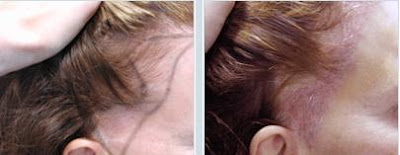By the age of 30 years about 30% of people have hair loss, about 50% have hair loss by age 50 years. Half of population in United states has the problem of hair loss but it's not a disease. Other animals closely related to humans, such as the chimpanzee, also lose their hair.

Hair Loss ( Alopecia)
Forms of hair loss
Androgenic alopecia - The most common type of hair loss, also called male pattern baldness
Traumatic alopecia - Hair loss from hair being torn out
Drug-induced alopecia - Hair loss caused by one of many medications
Alopecia areata - Patchy, usually reversible, hair loss
Women develop hair loss as frequently as men do, but because of hormonal differences women don't lose as much hair volume.
- Differences in hair styling allow women to hide hair loss more effectively than men.
- A woman may not notice hair loss itself but may notice that her ponytail or braid is getting thinner.
- Women also have a different pattern of balding than men.

Hair Loss Women
People with hair loss may sometimes be more likely to have a negative body image than those without hair loss. They could loose their self confidence. There are 3 cycles of hair growth-growing, resting, and shedding.
Hair Loss Men
- Each person sheds hair and regrows hair every day.
- When this balance is disturbed and more hairs are shed than are regrown, alopecia or hair loss results.
Symptoms
- Most people notice hair loss when looking at themselves in a mirror.
- Hairs on your pillow in the morning is the symptoms of abnormal hairloss.
- You may find hairs on comb while brushing your hair.
- A woman may notice a decrease in the size of her ponytail.
Hair Loss Pattern in Women
Hair Loss Pattern In Men
When To Seek Medical Treatment
Medical Treatment For Hair Loss









No comments:
Post a Comment